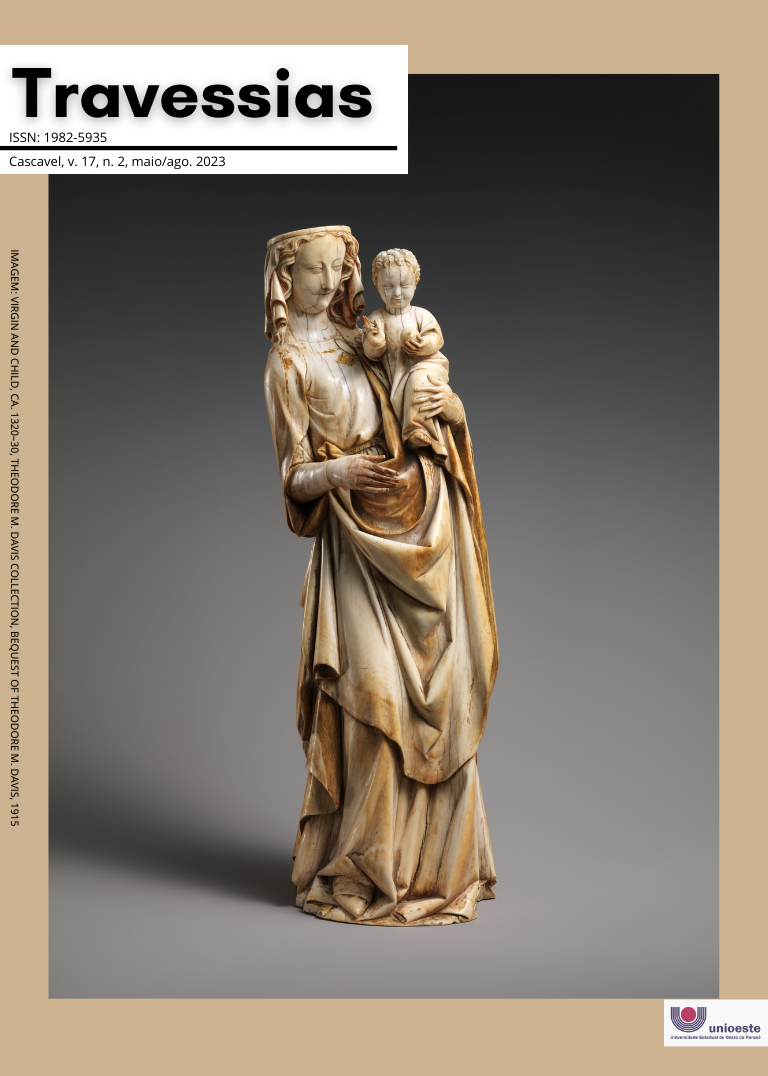A questão racial no ballet clássico da cidade de campos dos Goytacazes/RJ
DOI:
https://doi.org/10.48075/rt.v17i2.31191Palavras-chave:
Ballet Clássico, Racismo, Campos dos Goytacazes/RJResumo
O presente artigo trata-se de um recorte de uma dissertação de mestrado inserida no Programa de Pós-Graduação em Políticas Sociais da Universidade Estadual Norte Fluminense Darcy Ribeiro (UENF). É um estudo que trata da presença do corpo negro no ballet clássico. O mesmo tem como objetivo geral verificar a percepção dos/as bailarinos/as negros/as que atuam na área do ballet clássico sobre os efeitos do racismo estrutural nesta arte, tendo como destaque de análise a cidade Campos dos Goytacazes/RJ. A metodologia utilizada é de caráter descritiva e utilizou uma abordagem qualitativa. A técnica de amostragem utilizada foi a não probabilística denominada Bola de Neve (Vinuto, 2014). Para a coleta de dados, foram realizadas entrevistas semiestruturadas com os/as bailarinos/as negros/as residentes na cidade. Os dados foram analisados a partir da técnica de pesquisa Análise de Conteúdo defendida por Bardin (1977). Como principais resultados, percebemos que a maior parte dos bailarinos/as acredita na existência do racismo no ballet clássico da cidade em questão e enxergam este fenômeno, principalmente, através da pouca presença de alunos/as e professores/as de ballet clássico negros na cidade. Como considerações finais, concluímos que os/as bailarinos/as negros da cidade enxergam o racismo no ballet clássico local de variadas formas. Além disso, as autoras destacam a necessidade da produção de mais pesquisas nesta área, visando contribuir cada vez mais com a luta antirracista no ballet clássico.
Downloads
Referências
ALMEIDA, Silvio Luis de. Racismo Estrutural. São Paulo: Pólen, 2019.
ANUNCIAÇÃO, Gleidison Oliveira da. Do corpo negro no balé clássico ou das histórias que não se contam. 2021. 118 f. Dissertação (Mestrado) - Curso de Dança, Universidade Federal da Bahia, Salvador, 2021.
ASSUMPÇÃO, Andréa Cristhina Rufino. O balé clássico e a dança contemporânea na formação humana: caminhos para a emancipação. Pensar A Prática, Goiania, v. 6, n. 0, p. 1-20, 15 nov. 2006.
BARDIN, Laurence. Analise de Conteudo. São Paulo: Edições 70, 1977.
CARNEIRO, Sueli. Racismo, sexismo e desigualdade no Brasil. São Paulo: Selo Negro, 2011.
CEZARINO, Gabriela; PORTO, Eline. O CORPO NO BALLET CLÁSSICO: AS VOZES DOS BAILARINOS. Centro de Pesquisas Avançadas em Qualidade de Vida - Cpaqv Journal, [S. l.], v. 9, n. 3, p. 1-9, 2017.
GIL, Antônio Carlos. Como Elaborar Projetos de Pesquisa. 4. ed. São Paulo: Atlas, 2002.
HOOKS, Bell. Intelectuais Negras. Revista Estudos Feministas, Florianópolis, v. 3, n. 2, p. 1-15, jan. 1995.
MAIA, Kenia Soares; ZAMORA, Maria Helena Navas; BAPTISTA, Rachel Fontes. Reflexões sobre o racismo em Campos dos Goytacazes: Um olhar existencialista sobre a descolonização. Revista de Psicologia, Fortaleza, v. 10, n. 1, p. 137-147, jun. 2019.
MAURO, Mariana. Bailarinos negros dão piruetas em cima do racismo. 2015. Disponível em: https://www.geledes.org.br/bailarinos-negros-dao-piruetas-em-cima-do-racismo/. Acesso em: 10 maio 2021.
MUNANGA, Kabengele. A difícil tarefa de definir quem é negro no Brasil. Estudos Avançados, [S. l.], n. 50, p. 51-56, 2004.
PAULA, Franciane Kanzelumuka Salgado de; PAULA, Murilo de (org.). Mulheres negras na dança. São Paulo: Império do Livro, 2015.
PIRES, Cássia. As bailarinas negras e o ballet clássico. 2015. Blog. Disponível em: https://dospassosdabailarina.wordpress.com/2015/02/28/as-bailarinas-negras-e-o-ballet-classico/. Acesso em: 10 maio 2021.
RIBEIRO, Rafaela Machado. O negro e seu mundo: vida e trabalho no pós-abolição em campos dos goytacazes (1883-1893). 2012. 237 f. Dissertação (Mestrado) - Curso de Sociologia Política, Centro de Ciências do Homem, Universidade Estadual Norte Fluminense Darcy Ribeiro, Campos dos Goytacazes, 2012.
SILVA, Ingrid. A sapatilha que mudou meu mundo. Rio de Janeiro: Globo Livros, 2021.
SILVA JÚNIOR, Paulo Melgaço da; MELGAÇO, Matheus. Palco (in)visível:: os corpos negros no theatro municipal. In: FIGUEIRA, Arlene da Fonseca et al. (org.). ConexÕes Asas e RaÍzes: ancestralidade, representatividade e resistência. Recife: Even3 Publicações, 2019. p. 1-250.
SILVA JÚNIOR, Paulo Melgaço da. Mercedes Baptista: a criação da identidade negra na dança. Brasília: Fundação Cultural Palmares, 2007.
SILVÉRIO, Marcela Renata Costa. O corpo negro e o estereótipo da bailarina. 2020. 32 f. Monografia (Especialização) - Curso de Arte-Educação, Universidade Estadual de São Paulo, São Paulo, 2020.
VIANNA, Klauss. A dança. São Paulo: Summus Editorial, 2018.
VINUTO, Juliana. A AMOSTRAGEM EM BOLA DE NEVE NA PESQUISA QUALITATIVA: um debate em aberto. Temáticas, Campinas, n. 44, p. 1-18, ago. 2014.
Downloads
Publicado
Como Citar
Edição
Seção
Licença
Copyright (c) 2023 Autores mantêm os direitos autorais e concedem à revista o direito de primeira publicação, com o trabalho simultaneamente licenciado sob CC-BY-NC-SA 4.0 que permite o compartilhamento do trabalho com indicação da autoria e publicação inicial nesta revista

Este trabalho está licenciado sob uma licença Creative Commons Attribution-NonCommercial-ShareAlike 4.0 International License.
Aviso de Direito Autoral Creative Commons
Política para Periódicos de Acesso Livre
Autores que publicam nesta revista concordam com os seguintes termos:
1. Autores mantêm os direitos autorais e concedem à revista o direito de primeira publicação, com o trabalho simultaneamente licenciado sob a Licença Creative Commons Attribution que permite o compartilhamento do trabalho com reconhecimento da autoria e publicação inicial nesta revista.
2. Autores têm autorização para assumir contratos adicionais separadamente, para distribuição não-exclusiva da versão do trabalho publicada nesta revista (ex.: publicar em repositório institucional ou como capítulo de livro), com reconhecimento de autoria e publicação inicial nesta revista.
3. Autores têm permissão e são estimulados a publicar e distribuir seu trabalho online (ex.: em repositórios institucionais ou na sua página pessoal) a qualquer ponto antes ou durante o processo editorial, já que isso pode gerar alterações produtivas, bem como aumentar o impacto e a citação do trabalho publicado (Veja O Efeito do Acesso Livre).
Licença Creative Commons
Esta obra está licenciada com uma Licença Creative Commons Atribuição-NãoComercial-CompartilhaIgual 4.0 Internacional, o que permite compartilhar, copiar, distribuir, exibir, reproduzir, a totalidade ou partes desde que não tenha objetivo comercial e sejam citados os autores e a fonte.



